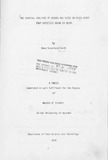| dc.description.abstract | Three varieties Patnangola,arherber and Hawaiin hybrid
of guavas grown in Kenya were used for analysis.
The enzymatlc method of juice preparation was preferred as
it was relatively cheaper and quicker. The yield was not of interest
in the juice preparation, and therefore was not calculated.
The acidity expressed as pH for the guava juice was 3.6.
The highest content of titratable acidity of 1.49% was of the
juice obtained from Hawaiin hybrid, followed by the juice of
the pink guava and the white guava.
White guava had the highest volatile acid content of
60 mg/100 ml, followed by pink guava with 34 mg/100 ml, and
lastly the Hawaiin hybrid wi th 24 mg/100 ml. Since very few
reports are available on the volatile compounds of guava, it
would be interesting and desirable to investigate the guava flavour.
Ascorbic acid varied from 120 mg/100 ml - 260 mg/100 ml in
the fruit. White guava had the highest ascorbic acid content.
Comparison between peel and pulp showed that the peel had a
higher ascorbic acid cont2nt than the pulp. On comparing unr
ipe and ripe guava, the results showed both the unripe peel
and pulp to have a higher ascorbic acid content than the ripe
peel and pulp.
Althouqh other workers have reported the presence of lactic
acid in guava, the acid was not found to be present in Kenya
guavas.
Tartaric acid was present in appreciable amount, white
guava juice contained 329 mg/100 ml , Hawa iin hybrid juice
310 mg/100 ml and pink guava contained 201 mg/100 ml. Tartaric
acid is considered characteristic of grapes, and is only present
in small quantities in other fruits.
Citric acid was confirmed to be the major non-volatile
organic acid and present in the highest quantity. The amount
varied between 805 mg/10Q ml - 440 mg/100 ml in the three varieties
analysed.
Calculation of the total sugar content, showed white guava
juice had 4.38 gm/100 ml after inversion. The pink guava juice
2.80 gm/100 ml and the Hawaiin hybrid 3.60 gm/100 ml.
The reducing sugar content of guava juice samples showed
that white guava contained 2.69 gm/100 ml, pink guava had 1.97
gm/100 ml and Hawa iin hybrid 2.16 gm/lOO ml. White guava had
the highest reducing sugar and total sugar content.
Sucrose content calculated from the total sugar contributed
33 to 42% of the total sugar in the three varieties analysed.
The soluble solids or sugars measured in °Brix were between
9 - 14 °Brix for the guava varieties analysed.
The mineral content averaged between 0.38 gm/100 ml to
0.6 gm/100 ml. The values depend more or less on the type of
soil and the climatic condition to which the plant has been
exposed. | en |

